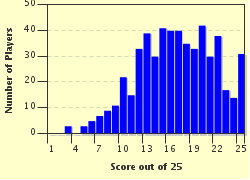Quiz Answer Key and Fun Facts
1. Which former US president is pictured on the US $500 bill? This bill is no longer being printed, but some still exist and they are still legal tender. (Hint: He was president during the Spanish-American war.)
2. Who is the future US president said to be holding the flag in the famous painting "Washington Crossing the Delaware"? This painting is a romanticized picture of General George Washington when he crossed the Delaware River in December 1776 during the American Revolutionary War. (Hint: No known relation to Marilyn.)
3. Who was the first US president to live in the Executive Mansion in Washington, DC (now called the White House)?
4. Which of these former US presidents have won the Nobel Peace Prize?
5. Who was the first US president to live in the Executive Mansion (now called the White House) AFTER it was burned out during the War of 1812?
6. Who was the first US president to be pictured on a US postage stamp? (Hint: Benjamin Franklin was the other person depicted on a US stamp issued that same year.)
7. Who was the US president who had a vice-president who co-wrote a number one hit song? (Hint: His nickname was "Silent _____.")
8. Which US president had a vice-president who was indicted for murder?
9. How many signers of the Declaration of Independence later became US presidents?
10. How many signers of the US Constitution later became US presidents?
11. How many US presidents signed both the Declaration of Independence and the Constitution?
12. Which of these presidents died on Independence Day (July 4th)?
13. Lawyer Francis Scott Key (author of the words of the "Star Spangled Banner") prosecuted a would-be assassin in a failed assassination attempt against what US president? (Hint: His nickname was "Old Hickory.")
14. Which of these former US presidents gained fame as a military leader before being elected?
15. How old was former President John Tyler when his 15th child was born? (Hint: The US president at the time was James Buchanan.)
16. Who was the first bachelor US president (before election, during his administration and when leaving office)?
17. Who was the first president elected by the Republican Party?
18. Which US president was a reluctant soldier who went on to achieve greatness as overall commanding general of the Union forces during the US Civil War?
19. Which US president had a wife who had the nickname "Lemonade Lucy"?
20. Who was the US president who SUPPOSEDLY got stuck in a White House bathtub?
21. Which of these former US presidents was the first elected to non-consecutive terms? He was elected, then lost his reelection bid, then ran again four years later and won.
22. Who was the US president who went on a fishing trip that resulted in this newspaper headline: "______ Fights 'Killer Rabbit' With Paddle On Fishing Trip"? (Hint: He is associated with peanuts.)
23. Which US president made his debate opponent laugh with the following debate line: "I will not make age an issue in this campaign. I am not going to exploit for political purposes my opponent's youth and inexperience"?
24. Who was the US president when women got the right to vote nationwide? This right was ratified in the 19th Amendment to the Constitution. (Hint: He sent General "Black Jack" Pershing to Mexico in search of Pancho Villa.)
25. Which US president's face is NOT carved on Mt. Rushmore, South Dakota?
Source: Author
root17
This quiz was reviewed by FunTrivia editor
stedman before going online.
Any errors found in FunTrivia content are routinely corrected through our feedback system.


